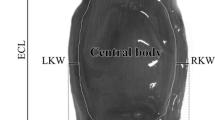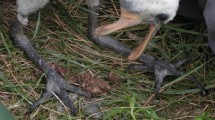Abstract
Mean predation rates (± SD) on egg cases of the skates Bathyraja macloviana, B. albomaculata, Amblyraja doellojuradoi, and Psammobatis spp. from the southwestern Atlantic were estimated to be 0.151 (±0.230), 0.423 (±0.344), 0.254 (±0.390), and 0.150 (±0.288), respectively. These estimates are within the ranges reported earlier (14–40%). Egg cases of B. albomaculata were preyed on in higher proportion than expected from their abundance and suffered a heavier predation rate where the snail Trophon acanthodes was present. Predation rates were not correlated with the thickness of the egg case wall, which indicates that other factors (ecological or chemical) could explain this pattern. Five types of boreholes were found in the egg cases: one was attributable to muricid gastropods, one to naticid gastropods, and a third type to an unknown gastropod (probably Fusitriton magellanicus); the remaining were of unknown origin. Cladistic analyses showed that skates are secondarily oviparous and have maximized adaptations for living in deep water. We suggest that oviparity in skates appeared as an adaptation to maximize fecundity (40–160 eggs per year, as compared to 2–18 pups annually or biannually in viviparous guitarfishes, the plesiomorphic sister clade of skates). If a predation rate of 24% (the mean of predation rates of all skate species studied to date) is applied to the range of fecundities reported for skates, the result is that 18–114 viable pups are produced annually per female skate. Even with a high mortality rate of 64% (the only direct estimate of natural mortality for any elasmobranch), each female skate produces 17–54 eggs annually. These values are higher than most elasmobranch fecundities. This maximization of fecundity is possible mainly because the fecundity of oviparous species is not limited by body size, as in viviparity. The protracted egg-laying season (4–12 months) of most skates (as in many other deep-sea fishes) maximizes the number of eggs laid.


Similar content being viewed by others
References
Ansell AD (1961) Egg capsules of the dogfish (Scyliorhinus canicula, Linn.) bored by Natica. (Gastropoda, Prosobranchia). Proc Malacol Soc Lond 34:248–249
Bremec CS, Lasta ML, Lucifora LO, Valero JL (1998) Análisis de la captura incidental asociada a la pesquería de vieira patagónica (Zygochlamys patagonica King & Broderip, 1832). INIDEP Inf Téc 22:1–18
Bunn NA, Fox CJ, Webb T (2000) A literature review of studies on fish egg mortality: implications for the estimation of spawning stock biomass by the annual egg production method. Sci Ser Tech Rep CEFAS 111:1–37
Capapé C (1977a) Contribution à la biologie des Rajidae des côtes tunisiennes VII—Raja melitensis Clark, 1926: sexualité, reproduction, fécondité. Cah Biol Mar 18:177–190
Capapé C (1977b) Contribution à la biologie des Rajidae des côtes tunisiennes X. Raja clavata Linné, 1758: etude complémentaire de la fécondité. Bull Off Nat Pêches Tunisie 1:169–172
Capapé C, Quignard J-P (1975) Essai d’évaluation de la fécondité chez les sélaciens ovipares: cas de Raja miraletus Linné, 1758 et de R. radula Delaroche, 1809 des côtes tunisiennes. Arch Inst Pasteur Tunis 52:263–276
Capapé C, Zaouali J (1994) Distribution and reproductive biology of the blackchin guitarfish, Rhinobatos cemiculus (Pisces: Rhinobatidae), in Tunisian waters (central Mediterranean). Aust J Mar Freshw Res 45:551–561
Carriker MR (1981) Shell penetration and feeding by naticacean and muricacean predatory gastropods: a synthesis. Malacologia 20:403–422
Carriker MR (1998) Predatory gastropod traces: a comparison of verified shallow-water and presumed deep-sea boreholes. Am Malacol Bull 14:121–131
Compagno LJV (2002) Sharks of the world, an annotated and illustrated catalogue of shark species known to date, vol 2. Bullhead, mackerel and carpet sharks (Heterodontiformes, Lamniformes and Orectolobiformes). FAO Species Catalogue for Fishery Purposes. FAO, Rome
Compagno LJV, Last PR (1999) Rhinobatidae. In: Carpenter KE, Niem VH (eds) The living marine resources of the western central Pacific, vol 3. Batoid fishes, chimaeras and bony fishes, part 1 (Elopidae to Linophrynidae). FAO, Rome, pp 1423–1430
Conover WJ (1980) Practical nonparametric statistics, 2nd edn. Wiley, New York
Cox DL, Koob TJ (1993) Predation on elasmobranch eggs. Environ Biol Fish 38:117–125
Cox DL, Walker P, Koob TJ (1999) Predation on eggs of the thorny skate. Trans Am Fish Soc 128:380–384
Dulvy NK, Reynolds JD (1997) Evolutionary transitions among egg-laying, live-bearing and maternal input in sharks and rays. Proc R Soc Lond B 264:1309–1315
Dulvy NK, Reynolds JD (2002) Predicting extinction vulnerability in skates. Conserv Biol 16:440–450
Ellis JR, Shackley SE (1995) Observations on egg-laying in the thornback ray. J Fish Biol 46:903–904
Fuentealba M, Leible M (1990) Perspectivas de la pesquería de raya volantín Raja (Dipturus) flavirostris: estudio de edad, crecimiento y algunos aspectos reproductivos. In: Barbieri MA (ed) Perspectivas de la actividad pesquera en Chile. Escuela de Ciencias del Mar Universidad Católica de Valparaíso, Valparaíso, Chile, pp 227–236
Gage JD, Tyler PA (1992) Deep-sea biology: a natural history of organisms at the deep-sea floor. Cambridge University Press, Cambridge
Gordillo S (1994) Perforaciones en bivalvos subfósiles y actuales del Canal Beagle, Tierra del Fuego. Ameghiniana 31:177–185
Grover CA (1972) Predation on egg-cases of the swell shark, Cephaloscyllium ventriosum. Copeia 1972:871–872
Hamlett WC, Koob TJ (1999) Female reproductive system. In: Hamlett WC (ed) Sharks, skates, and rays: the biology of elasmobranch fishes. Johns Hopkins University Press, Baltimore, Md., pp 398–443
Hensley RA, McCoid MJ, Luer CA (1998) Litter variation in the Atlantic guitarfish (Rhinobatidae: Rhinobatos lentiginosus) with comments on distribution in the Gulf of Mexico. Southw Nat 43:501–504
Holden MJ (1975) The fecundity of Raja clavata in British waters. J Cons Int Explor Mer 36:110–118
Holden MJ, Rout DW, Humphreys CN (1971) The rate of egg-laying by three species of ray. J Cons Int Explor Mer 33:335–339
Jacobs J (1974) Quantitative measurement of food selection: a modification of the forage ratio and Ivlev’s electivity index. Oecologia 14:413–417
Koob TJ (1991) Deposition and binding of calcium and magnesium in egg capsules of Raja erinacea Mitchill during formation and tanning in utero. Copeia 1991:339–347
Kormanik GA (1993) Ionic and osmotic environment of developing elasmobranch embryos. Environ Biol Fish 38:223–240
Kyne PM, Bennett MB (2002) Reproductive biology of the eastern shovelnose ray, Aptychotrema rostrata (Shaw & Nodder, 1794), from Moreton Bay, Queensland, Australia. Mar Freshw Res 53:583–589
Lessa RP, Vooren CM, Lahaye J (1986) Desenvolvimento e ciclo sexual das fêmeas, migrações e fecundidade da viola Rhinobatos horkelii (Müller & Henle, 1841) do sul do Brasil. Atlântica 8:5–34
Mabragaña E, Lucifora LO, Massa AM (2002) The reproductive ecology and abundance of Sympterygia bonapartii endemic to the southwest Atlantic. J Fish Biol 60:951–967
Manire CA, Gruber SH (1993) A preliminary estimate of natural mortality of age-0 lemon sharks, Negaprion brevirostris. In: Branstetter S (ed) Conservation biology of elasmobranchs. NOAA Tech Rep NMFS 115:65–71
McEachran JD, Dunn KA (1998) Phylogenetic analysis of skates, a morphologically conservative clade of elasmobranchs (Chondrichthyes: Rajidae). Copeia 1998:271–290
Nishida K (1990) Phylogeny of the suborder Myliobatidoidei. Mem Fac Fish Hokkaido Univ 37:1–108
Schwartz FJ, Maddock MB (2002) Cytogenetics of the elasmobranchs: genome evolution and phylogenetic implications. Mar Freshw Res 53:491–502
Smith C, Griffiths C (1997) Shark and skate egg-cases cast up on two South African beaches and their rates of hatching success, or causes of death. S Afr J Zool 32:112–117
Templeman W (1982) Development, occurrence and characteristics of egg capsules of the thorny skate, Raja radiata, in the northwest Atlantic. J Northw Atl Fish Sci 3:47–56
Villavicencio-Garayzar CJ (1993) Biología reproductiva de Rhinobatos productus (Pisces: Rhinobatidae), en Bahía Almejas, Baja California Sur, México. Rev Biol Trop 41:777–782
Villavicencio-Garayzar CJ (1995) Reproductive biology of the banded guitarfish, Zapterix exasperata (Pisces: Rhinobatidae), Bahía Almejas, Baja California Sur, Mexico. Cienc Mar 21:141–153
Wenbin Z, Shuyuan Q (1993) Reproductive biology of the guitarfish, Rhinobatos hynnicephalus. Environ Biol Fish 38:81–93
Zar JH (1984) Biostatistical analysis, 2nd edn. Prentice Hall, Englewood Cliffs, N.J.
Acknowledgements
We thank M.L. Lasta, C.S. Bremec, and A. Marecos for help in the collection of samples. A.M. Massa and N.M. Hozbor kindly assisted us with the digital image analysis. We also thank C. Capapé for valuable comments that greatly improved the manuscript.
Author information
Authors and Affiliations
Corresponding author
Additional information
Communicated by P.W. Sammarco, Chauvin
Rights and permissions
About this article
Cite this article
Lucifora, L.O., García, V.B. Gastropod predation on egg cases of skates (Chondrichthyes, Rajidae) in the southwestern Atlantic: quantification and life history implications. Marine Biology 145, 917–922 (2004). https://doi.org/10.1007/s00227-004-1377-8
Received:
Accepted:
Published:
Issue Date:
DOI: https://doi.org/10.1007/s00227-004-1377-8




